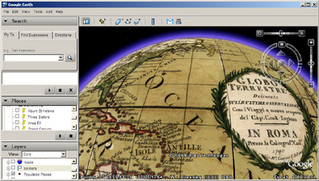Google Earth KMLs can now be viewed in Google Maps


A web site discussing geospatial technologies in education
Google Earth KMLs can now be viewed in Google Maps


Google Earth and Old Maps?!? Be still my heart!

Google Earth in 4D by ZDNet's Garett Rogers -- Google skipped right past the third dimension and landed directly in the fourth (time) by offering historical maps on Google Earth. Now you can travel back in time — for example, I am looking at the globe of 1790. Don't expect detailed high resolution photography from days gone by, but it's still interesting to see [...]
So, in order to make these fantastic archival maps transparent, look at the image below. If you cannot read it, you have to select the folder (highlight it) in the Rumsey collection under the Featured Content and then up in the Places section you'll see the Transparency slider.

Five College GIS Day - Pioneer Valley, Massachusetts
If you are nearby, or in the region, or even farther away, you are
invited to attend our Five College GIS Day!
All events are on November 8, 2006 at Amherst College in Amherst,
Massachusetts (72° 31' W, 42° 22' N).
Full information can be found here:
http://www.amherst.edu/it/ats/gisday/
You can contact me if you have other questions, or just to let me
know you're coming (and maybe bringing a poster, hint, hint).
The schedule is as follows. All events are free and open to the public.
Thanks,
-- Andy
****************************************************
10:30 AM - 11:30 AM
GIS and Demography: Methods, Analysis, Results
Dr. Ian Gregory, Digital Humanities-Department of History, Lancaster
University, UK
A seminar for experienced users of GIS, applicable to history,
sociology, economics, et al.
12:00 Noon - 12:50 PM
Teaching History with Geographic Information Systems
Prof. Robert M. Schwartz, E. Nevius Rodman Professor of History, Mt.
Holyoke College, MA
Discover how GIS can help introduce quantitative methods into history
and other subjects.
2:00 PM - 4:00 PM
GIS Poster Session
Everyone is invited to set up posters demonstrating academic
applications of GIS.
Visitors can take a short poster quiz to be included in a drawing to
win a door prize, including a GPS receiver!
4:00 PM - 5:00 PM
GIS and the Exploration of French Society and Culture
Prof. Joel Goldfield, Chair of Modern Languages and Literatures,
Fairfield University, CT
Learn how students used GIS-based projects to collaborate across
multiple disciplines.
7:30 PM - 9:00 PM
The Journey of Man: A Genetic Odyssey
Dr. Spencer Wells, Explorer-in-Residence, The National Geographic
Society,
and Project Director of the Genographic Project
Roughly sixty thousand years ago our ancestors began to spread out
across Africa and throughout the world. Our keynote speaker has
mapped this prehistoric journey using cutting-edge genetic research
informed by archaeology, linguistics, and climatology.
****************************************************
P.S. I know we're early, but November 8 fits our academic schedule
better :-).
Andy Anderson, Ph.D.
Mathematical and Spatial Data Analysis Specialist
Academic Technology Services
Amherst College
413-542-2255
GIS Demos at Cornell Cooperative Extension - Millbrook, NY
From: Stacy Hoppen
Sent: Wednesday, November 01, 2006 2:22 PM
To: GIS SIG
Subject: Wed Nov 8, 2006 - 6:30 pm - 8:30 pm - Demos of Free GIS Software
To: GIS SIG
Reminder for our event next week, on GIS Day!
Wednesday Nov 8, 2006 - 6:30 pm - 8:30 pm
Conference Room A
Farm and Home Center
2715 Route 44, Millbrook, NY
Demonstrations of Free GIS Software
Review and demos of some of the free GIS software packages available for
download from Internet. Demos will be about 20 minutes for each software
package.
Google Earth and Google SketchUp - Joe Heggenstaller
3DEM - 3D visualization software - Stacy Hoppen
Build Out Analysis software from University of Vermont - Mark Doyle/Stacy
Hoppen
Quantum GIS - Jerry Ottaway
MicroCAM - Stacy Hoppen
Feel free to pass this on to anyone who may be interested. Hope to see you
there!
Stacy
Stacy Hoppen
Interim GIS Project Coordinator
Cornell Cooperative Extension, Environment Program Farm and Home Center
2715 Route 44
Millbrook, NY 12545
845-677-8223 x148
845-677-6563 fax


